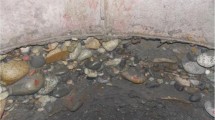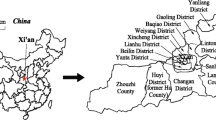Abstract
Mechanism and modeling of the land subsidence are complex because of the complicate geological background in Beijing, China. This paper analyzed the spatial relationship between land subsidence and three factors, including the change of groundwater level, the thickness of compressible sediments and the building area by using remote sensing and GIS tools in the upper-middle part of alluvial-proluvial plain fan of the Chaobai River in Beijing. Based on the spatial analysis of the land subsidence and three factors, there exist significant non-linear relationship between the vertical displacement and three factors. The Back Propagation Neural Network (BPN) model combined with Genetic Algorithm (GA) was used to simulate regional distribution of the land subsidence. Results showed that at field scale, the groundwater level and land subsidence showed a significant linear relationship. However, at regional scale, the spatial distribution of groundwater depletion funnel did not overlap with the land subsidence funnel. As to the factor of compressible strata, the places with the biggest compressible strata thickness did not have the largest vertical displacement. The distributions of building area and land subsidence have no obvious spatial relationships. The BPN-GA model simulation results illustrated that the accuracy of the trained model during fifty years is acceptable with an error of 51% of verification data less than 20 mm and the average of the absolute error about 32 mm. The BPN model could be utilized to simulate the general distribution of land subsidence in the study area. Overall, this work contributes to better understand the complex relationship between the land subsidence and three influencing factors. And the distribution of the land subsidence can be simulated by the trained BPN-GA model with the limited available dada and acceptable accuracy.
Similar content being viewed by others
References
Altun A A, Allahverdi N, 2007. Neural network based recognition by using genetic algorithm for feature selection of enhanced fingerprints. In: Beliczynski B (eds.). Adaptive and Natural Computing Algorithms. Germany: Springer Berlin Heidelberg, 467–476.
Barends F B J, 2010. Review of subsidence management in the Netherlands. In: Dora C F (eds.). Land Subsidence, Associated Hazards and the Role of Natural Resources Development. British: International Association of Hydrological Sciences Press, 385–395.
Bhise O P, Pratihar D K, 2006. Neural network-based expert system to predict the results of finite element analysis. In: Tiwari A (eds.). Applications of Soft Computing. Germany: Springer Berlin Heidelberg, 231–240.
Burbey T J, 2006. Three-dimensional deformation and strain induced by municipal pumping, Part 2: Numerical analysis. Journal of Hydrology, 330(3–4): 422–434. doi: 10.1016/j.jhydrol.2006.03.035
Calderhead A I, Therrien R, Rivera A et al., 2011. Simulating pumping-induced regional land subsidence with the use of InSAR and field data in the Toluca Valley, Mexico. Advances in Water Resources, 34(1): 83–97. doi:10.1016/j.advwatres.2010.09.017
Cui Yali, Shao Jingli, Xie Zhenghua et al., 2003. Research on the ground settlement model based on MODFLOW. Geotechnical Investigation & Surveying, (5): 19–22. (in Chinese)
Fiszelew A, Britos P, Ochoa A et al., 2007. Finding optimal neural network architecture using genetic algorithms. Research in Computing Science, 27: 15–24.
Galloway D L, Burbey T J, 2011. Review: Regional land subsidence accompanying groundwater extraction. Journal of Hydrogeology, 19(8): 1459–1486. doi: 10.1007/s10040-011-0775-5
Galloway D L, Hoffmann J, 2007. The application of satellite differential SAR interferometry-derived ground displacements in hydrogeology. Journal of Hydrogeology, 15(1): 133–154. doi: 10.1007/s10040-006-0121-5
Gong H L, Zhang Y Q, Li X J et al., 2008. Modeling atmospheric effects of InSAR measurements based on Meris and GPS observations. International Geoscience & Remote Sensing Symposium, 4: IV-978–IV-981. doi: 10.1109/IGARSS.2008.4779888
Gong Huili, 2009. Study on the Mechanism and the Monitoring Technology of the Land Subsidence. Beijing: Report of Laboratory Cultivation Base of Environment Process and Digital Simulation. (in Chinese)
Jia Sanman, Wang Haigang, Zhao Shousheng et al., 2007. A tentative study of the mechanism of land subsidence in Beijing. Analysis and Study, 2(1): 20–26. (in Chinese)
Karegowda A G, Manjunath A S, Jayaram M A, 2011. Application of genetic algorithm optimized neural network connection weights for medical diagnosis of pima Indians diabetes. International Journal on Soft Computing, 2(2): 15–23. doi: 10.5121/ijsc.2011.2202
Leake S A, Galloway D L, 2007. MODFLOW ground-water model—User guide to the Subsidence and Aquifer-System Compaction Package (SUB-WT) for water-table aquifers. In: U.S. Geological Survey, Techniques and Methods, 6–A23.
Leake S A, Galloway D L, 2010. Use of the SUB-WT package for MODFLOW to simulate aquifer system compaction in Antelope valley, California, USA. In: Dora C F (eds.). Land Subsidence, Associated Hazards and the Role of Natural Resources Development. British: International Association of Hydrological Sciences Press, 61–67.
Li Hongxia, Zhang Jianxiong, Zhao Xinhua, 2008. A land subsidence model based on a chaos optimization algorithm and a BP neural network. Journal of China University of Mining & Technology, 37(3): 396–401. (in Chinese)
Li Hongxia, Zhao Xinhua, Chi Haiyan et al., 2009. Prediction and analysis of land subsidence based on improved BP neural network model. Journal of Tianjin University, 42(1): 60–64. (in Chinese)
Li Tao, Pan Yun, Lou Huajun et al., 2005. Application of the artificial neural network in land subsidence prediction in the urban area of Tianjin Municipality, China. Geological Bulletin of China, 24(7): 677–681. (in Chinese)
Li Y Y, Zhu L, Zhao L J et al., 2011. Study on the BP-GA model and its application in water quality assessment. Water Resource and Environmental Protection, 4: 2781–2784. doi: 10.1109/ISWREP.2011.5893456
Liu Yu, Ye Chao, Jia Sanman, 2007. Division of water-bearing zones and compressible layers in Beijing’s land subsidence areas. Analysis and Study, 2(1): 10–15. (in Chinese)
Moghadassi A R, Parvizian F, Abareshi B et al., 2010. Optimization of regenerative cycle with open feed water heater using genetic algorithms and neural networks. Journal of Therm Analysis and Calorimetry, 100(3): 757–761. doi: 10.1007/s10973-010-0727-7
Montana D J, Davis L, 1989. Training feedforward neural networks using genetic algorithms. In: Morgan K (eds.). Proceedings of the 11th International Joint Conference on Artificial Intelligence, 762–767.
Shi X Q, Xue Y Q, Wu J C et al., 2008. Characteristics of regional land subsidence in Yangtze Delta, China: An example of Su-Xi-Chang area and the City of Shanghai. Hydrogeology Journal, 16(3): 593–607. doi: 10.1007/s10040-007-0237-2
Strozi T, Tosi L, Teatini P et al., 2010. Advanced monitoring tech niques for mapping land displacement on the Venice coastland with satellite SAR data. In: Dora C F (eds.). Land Subsidence, Associated Hazards and the Role of Natural Resources Development. British: International Association of Hydrological Sciences Press, 249–254.
Tian Fang, Guo Meng, Luo Yong et al., 2012. The deformation be havior of soil mass in the subsidence area of Beijing. Geology in China, 39(1): 236–242. (in Chinese)
Tomas R, Herrera G, Cooksley G et al., 2011. Persistent Scatterer Interferometry subsidence data exploitation using spatial tools: The Vega Media of the Segura River Basin case study. Journal of Hydrology, 400(3–4): 411–428. doi:10.1016/j.jhydrol.2011.01.057
Venkatsan D, Kannan K, Saravanan R, 2009. A genetic algorithmbased articial neural network model for the optimization of ma chining processes. Neural Computing & Applications, 18(2): 135–140. doi: 10.1007/s00521-007-0166-y
Yang Yan, Jia Sanman, Wang Haigang, 2010, The status and development of land subsidence in Beijing plain. Shanghai Geology, 31(4): 23–27. (in Chinese)
Ye S J, Xue Y Q, Wu J C et al., 2010. A regional land subsidence model embodying complex deformation characteristics. In: Dora C F (eds.). Land Subsidence, Associated Hazards and the Role of Natural Resources Development. British: International Association of Hydrological Sciences Press, 76–81.
Yu J, Su S, Zhu L et al., 2010. Research on a 3-D visualized strata model virtual reality system of land subsidence in Suzhou-Wuxi-Changzhou area. In: Dora C F (eds.). Land Subsidence, Associated Hazards and the Role of Natural Resources Development. British: International Association of Hydrological Sciences Press, 108–113.
Zhang Y Q, Gong H L, Chen B B et al., 2009. Seasonal displacements in upper-middle alluvial fan of Chaobai River, Beijing, China, observed by the permanent scatters technique. Joint Urban Remote Sensing Event, 1423–1428. doi: 10.1109/URS.2009.5137709
Zhu L, Gong H L, Jing L L et al., 2009. Research on evolution of land subsidence induced by nature and human activity by utilizing remote sensing technology. Joint Urban Remote Sensing Event, 1331–1335. doi: 10.1109/URS.2009.5137693
Author information
Authors and Affiliations
Corresponding author
Additional information
Foundation item: Under the auspices of National Natural Science Foundation of China (No. 41201420, 41130744), Beijing Nova Program (No. Z111106054511097), Foundation of Beijing Municipal Commission of Education (No. KM201110028016)
Rights and permissions
About this article
Cite this article
Zhu, L., Gong, H., Li, X. et al. Comprehensive analysis and artificial intelligent simulation of land subsidence of Beijing, China. Chin. Geogr. Sci. 23, 237–248 (2013). https://doi.org/10.1007/s11769-013-0589-6
Received:
Accepted:
Published:
Issue Date:
DOI: https://doi.org/10.1007/s11769-013-0589-6




